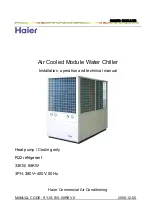
16
6 INCH CHIPPER
OPERATION
7. Limbs fed in to the chipper chute must be 6"
(15.2 cm) in diameter or less.
Trim side branches
that cannot be bent enough to feed into the chipper
chute. Hold small diameter branches together in a
bundle and feed in simultaneously.
8. Alternate green or fresh cut material with dry
material to lubricate the chipping blades for
longer life and better performance.
Chipping dead,
dry material will create heat and dull the chipping
blades quickly.
9. ALWAYS feed brush from the side of the chipper
chute,
rather than from the front. Step aside to avoid
being hit by the brush moving into the chipper.
10.
ALWAYS place limb, butt end first, into the
chipper chute until it contacts the chipper blades.
The actual feed rate of the limb into the chipper will
depend on the type of material fed and sharpness of
the cutting blades.
11. NEVER use the belt engagement to clear a
plugged rotor.
This may cause belt damage. Refer
to the instructions for clearing a plugged rotor in the
Service and Maintenance section.
12. NEVER
attempt to clear a plugged rotor or discharge
with the engine running.
ALWAYS
shut engine OFF
before servicing any part of this machine
13. NEVER
attempt to chip pieces of metal, rock, bottles,
cans or other foreign objects.
Read and follow all safety instructions in this manual.
Failure to operate the machine in accordance with
the safety instructions
MAY RESULT IN PERSONAL
INJURY!
WARNING
4.3 CHIPPER OPERATION GUIDELINES
The machine chips a variety of materials into a more
readily decomposed or handled condition. The following
guidelines will help you get started.
1. Gradually increase engine speed until full throttle
is achieved.
When the controller light is steady green
the engine speed is high enough to begin to chip.
2. ALWAYS
run engine at full operating speed before
starting to chip material.
3. Engage the hydraulic feed
by pushing the forward
button from the Chipping Screen (see Section 4.7 for
more details on utilizing the Digital Display Controller).
4. If the chipper rotor slows, stop feeding material.
The feed roller will stop automatically to process
backed up material. Feed material more evenly.
5. If the chipper jams,
the feed roller will reverse
momentarily to remove the branch. Once the branch
is removed, rotate it before reinserting into the
chute. Alternately insert and retract the limb or insert
continuously at a rate that will not kill the engine.
6. Sharpen the chipping blades periodically.
Check
the sharpness of the blades every 5-15 hours. Refer to
the Service and Maintenance section for sharpening
instructions.
●
Never
lean over the chipper chute to push objects
into the cutting device. Use a push stick or brush
paddle.
●
Never
use shovels or forks to feed brush. They
can cause extensive damage if they contact the
blades. In addition, metal pieces can be ejected
from the chipper chute and cause serious injury
or death.
●
Never
feed brush into the chute with your feet.
●
Never
use hands or feet to clear materials that
build up in the chute.
CAUTION
●
Obtain and wear safety glasses at all times when
operating the machine.
● Do not wear loose fitting clothing.
●
The operator should always wear heavy boots,
gloves, pants and a long-sleeved shirt.
●
Use common sense and practice safety to protect
yourself from branches, sharp objects, and other
harmful objects.
CAUTION
















































